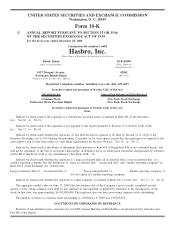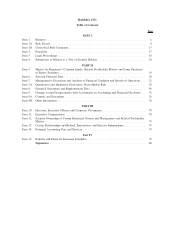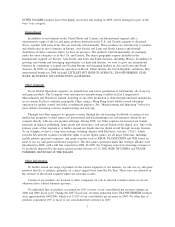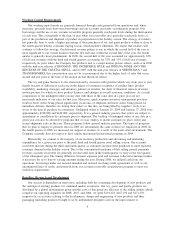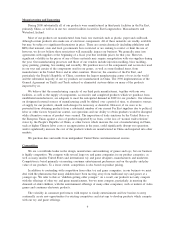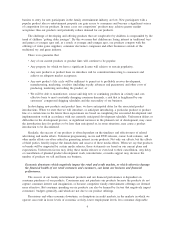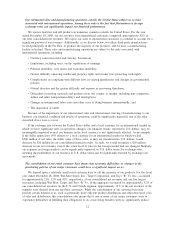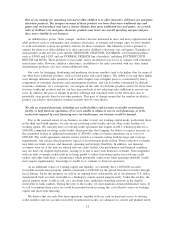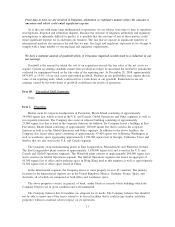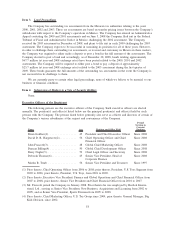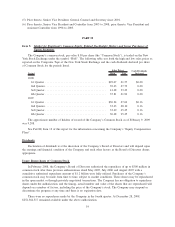Hasbro 2008 Annual Report Download - page 19
Download and view the complete annual report
Please find page 19 of the 2008 Hasbro annual report below. You can navigate through the pages in the report by either clicking on the pages listed below, or by using the keyword search tool below to find specific information within the annual report.barriers to entry for new participants in the family entertainment industry are low. New participants with a
popular product idea or entertainment property can gain access to consumers and become a significant source
of competition for our products. In some cases our competitors’ products may achieve greater market
acceptance than our products and potentially reduce demand for our products.
The challenge of developing and offering products that are sought after by children is compounded by the
trend of children “getting older younger”. By this we mean that children are losing interest in traditional toys
and games at younger ages and, as a result, at younger and younger ages, our products compete with the
offerings of video game suppliers, consumer electronics companies and other businesses outside of the
traditional toy and game industry.
There is no guarantee that:
• Any of our current products or product lines will continue to be popular;
• Any property for which we have a significant license will achieve or sustain popularity;
• Any new products or product lines we introduce will be considered interesting to consumers and
achieve an adequate market acceptance;
• Any new product’s life cycle will be sufficient to permit us to profitably recover development,
manufacturing, marketing, royalties (including royalty advances and guarantees) and other costs of
producing, marketing and selling the product; or
• We will be able to manufacture, source and ship new or continuing products in a timely and cost-
effective basis to meet constantly changing consumer demands, a risk that is heightened by our
customers’ compressed shipping schedules and the seasonality of our business.
In developing new products and product lines, we have anticipated dates for the associated product
introductions. When we state that we will introduce, or anticipate introducing, a particular product or product
line at a certain time in the future those expectations are based on completing the associated development and
implementation work in accordance with our currently anticipated development schedule. Unforeseen delays or
difficulties in the development process, or significant increases in the planned cost of development, may cause
the introduction date for products to be later than anticipated or, in some situations, may cause a product
introduction to be discontinued.
Similarly, the success of our products is often dependent on the timelines and effectiveness of related
advertising and media efforts. Television programming, movie and DVD releases, comic book releases, and
other media efforts are often critical in generating interest in our products. Not only our efforts, but the efforts
of third parties, heavily impact the launch dates and success of these media efforts. When we say that products
or brands will be supported by certain media releases, those statements are based on our current plans and
expectations. Unforeseen factors may delay these media releases or even lead to their cancellation. Any delay
or cancellation of planned product development work, introductions, or media support may decrease the
number of products we sell and harm our business.
Economic downturns which negatively impact the retail and credit markets, or which otherwise damage
the financial health of our retail customers and consumers, can harm our business and financial
performance.
The success of our family entertainment products and our financial performance is dependent on
consumer purchases of our products. Consumers may not purchase our products because the products do not
capture consumer interest and imagination, or because competitor family entertainment offerings are deemed
more attractive. But consumer spending on our products can also be harmed by factors that negatively impact
consumers’ budgets generally, and which are not due to our product offerings.
Recessions and other economic downturns, or disruptions in credit markets, in the markets in which we
operate can result in lower levels of economic activity, lower employment levels, less consumer disposable
9


